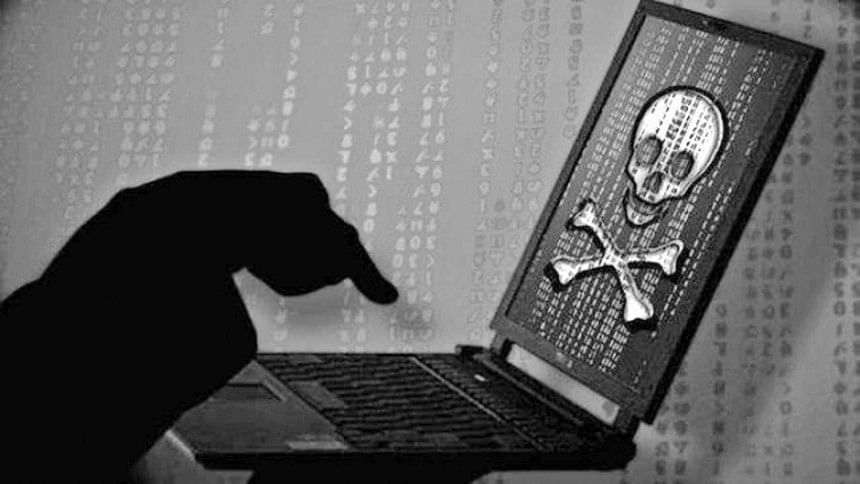A scary glimpse of malware havoc?

Since last week, the world has woken up to the "largest Ransomware attack in internet history." Its unprecedented and extensive nature has had cyber forensic experts (still caught on a learning curve!) and remediation alliances working over time to get to the bottom of it.
According to a top US official, after disruptions affecting networks worldwide, 300,000 computers had been affected. But the infection rates have slowed down since peaking last week even though a second spell has not been not ruled out.
Pointing to the fallout, which is still unfolding, a top Europol executive told the BBC that as many as 150 countries have been affected. When you think of that many countries being impacted, the contamination of 300,000 computers as indicated in the US sounds like an understatement. It may have been just an initial interim assessment; yet the collateral damages to the institutions couldn't be trifled with.
It's concerning that Bangladesh is on the list of the affected. Hardly a surprise, recalling the Bangladesh Bank cyber heist which hogged international headlines. Actually, a hundred cases of ransomware attacks have been reported in Bangladesh until Tuesday evening, according to a prominent financial daily.
In their quest for unravelling the latest cyber hacking mystery (which was perhaps just waiting to happen), experts tend to categorise the phenomenon under two broad heads: State-sponsored cyber invasions and criminality induced hacks.
Examples of state sponsored hackings are centred around Russia's purported intrusions into US presidential Democrat candidate Hilary Clinton's electoral campaign to favour Trump candidacy in the November polls. Also, suspicions have been expressed in the public domain about attempted hackings into the election campaigns of present French president Emanuel Macron and that of German presidential hopeful Angela Merkel.
We have also seen how classified information has been played ping-pong with. Hillary Clinton was faulted for using official server on her email account in breach of trust. By a strange turn and twist, it is now President Trump who has declassified the contents of his conversions with Putin. Mrs. Clinton's indiscretion, her supporters will claim, pales before that of Trump declassifying documents before the stipulated time period.
State secrets are perhaps less sacrosanct now than they used to be, encouraging cyber hacking in a context diluted by inter-personal relationships.
Knowledgeable circles have come to believe that a criminal underworld of the internet is growing - immersed in a devil's workshop, experimenting with malwares to break into a system. They have given it a picturesque name viz "darkware world". Like an underground economy, there's an underground internet.
For considerations of credibility and social responsibility, as conduits of communication, Facebook, Google and Apple are taking to a policy of pre-filtration of entries on to their canvas.
Now comes the big question: Who triggered the massive cyber attack, pervasively disrupting computer systems the world over? An AFP report from Washington said, "In the first clues of the origin of the massive ransomware attacks, Google researcher Neel Mehta posted computer code that showed similarities between the "WannaCry" malware and a vast hacking effort widely attributed to Pyongyang." Along the same line, Simon Choi, director of the Seoul internet security firm Hauri stated, "The code used in the latest attack shared many similarities with past hacks blamed on the North."
But Europol with a broad spectrum cyber intelligence network warns against rash judgement adding it is "too early" to say who is behind the hacks.
Well, where are we placed in an overall context? A survey conducted by the Bangladesh Institute of Bank Management (BIBM) has revealed the vulnerability of local banks. In the last three years, they have been subject to "cyber intrusions or attempted cyber intrusions in their IT systems." The most common mischievous activities resulting from cyber intrusion were "account takeovers (7.0 percent), identity theft (18 percent), telecommunication network disruptions (15 percent) and data integrity breaches (9.0 percent)", found a study.
One hopes that apart from nudging other important institutions into ramping up safeguards against cyber attacks, the latest wave of hacking should make financial institutions flesh up on the bare bones of their IT structures. The inadequacies are scary: "Only 22 percent of the banks have IT governance framework in place; 12 percent have for some level of IT roadmap; and frustratingly, almost 50 percent of bank auditors are not trained enough to perform IT audit properly."
The writer is a commentator on current affairs and former Associate Editor, The Daily Star.

 For all latest news, follow The Daily Star's Google News channel.
For all latest news, follow The Daily Star's Google News channel. 



Comments